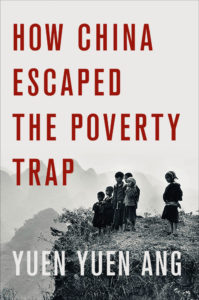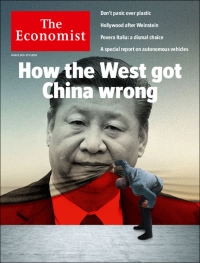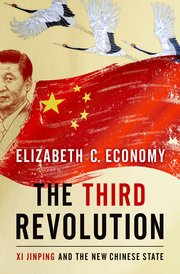 Most Western observers have long believed that democracy and capitalism go hand in hand, that economic liberalization both requires and propels political liberalization, notes Yuen Yuen Ang, Associate Professor of Political Science at the University of Michigan and the author of How China Escaped the Poverty Trap. China’s apparent defiance of this logic has led to two opposite conclusions, she writes for Foreign Affairs:
Most Western observers have long believed that democracy and capitalism go hand in hand, that economic liberalization both requires and propels political liberalization, notes Yuen Yuen Ang, Associate Professor of Political Science at the University of Michigan and the author of How China Escaped the Poverty Trap. China’s apparent defiance of this logic has led to two opposite conclusions, she writes for Foreign Affairs:
- One camp insists that China represents a temporary aberration and that liberalization will come soon. But this is mostly speculation; these analysts have been incorrectly predicting the imminent collapse of the Chinese Communist Party (CCP) for decades.
- The other camp sees China’s success as proof that autocracies are just as good as democracies at promoting growth—if not better. …In fact, some are utterly disastrous, including China under Mao.
 Both of these explanations overlook a crucial reality: since opening its markets in 1978, China has in fact pursued significant political reforms—just not in the manner that Western observers expected, she contends:
Both of these explanations overlook a crucial reality: since opening its markets in 1978, China has in fact pursued significant political reforms—just not in the manner that Western observers expected, she contends:
Instead of instituting multiparty elections, establishing formal protections for individual rights, or allowing free expression, the CCP has made changes below the surface, reforming its vast bureaucracy to realize many of the benefits of democratization—in particular, accountability, competition, and partial limits on power—without giving up single-party control. Although these changes may appear dry and apolitical, in fact, they have created a unique hybrid: autocracy with democratic characteristics.
“But can this approach forestall pressure for individual rights and democratic freedoms forever?” she asks. “Today, there are increasing signs that the bureaucracy has come close to exhausting its entrepreneurial and adaptive functions.”
 China is expanding its ability to project information globally, both through traditional state media outlets and through a wide range of Internet and social media tools, adds Council on Foreign Relations analyst Joshua Kurlantzick. Xi Jinping has, much more forcefully than other Chinese leaders, stated that he wants other countries to look to China as a model, and appears to be overseeing a growing “sharp power” campaign of trying to influence other countries through means more hidden, and potentially more coercive, than traditional soft power efforts.
China is expanding its ability to project information globally, both through traditional state media outlets and through a wide range of Internet and social media tools, adds Council on Foreign Relations analyst Joshua Kurlantzick. Xi Jinping has, much more forcefully than other Chinese leaders, stated that he wants other countries to look to China as a model, and appears to be overseeing a growing “sharp power” campaign of trying to influence other countries through means more hidden, and potentially more coercive, than traditional soft power efforts.
 Xi’s vision of a new era is far from the society he rules today, notes Columbia University’s Andrew J. Nathan. After forty years of explosive growth, the Chinese are striving, dissatisfied, and anxious, he writes for the New York Review of Books:
Xi’s vision of a new era is far from the society he rules today, notes Columbia University’s Andrew J. Nathan. After forty years of explosive growth, the Chinese are striving, dissatisfied, and anxious, he writes for the New York Review of Books:
They suffer from a spiritual crisis that has led to a rise in religious practice and from tension between the government and the ethnic minorities. And yet the government is widely popular among broad sectors of the population, many of which have experienced dramatic improvements in their material lives. Xi has built on the efforts of his predecessors to expand the social welfare system, improve health care, raise the incomes of rural people, and enable some rural residents to get urban residency permits.
For the first time, China is an illiberal state seeking leadership in a liberal world order, argues Elizabeth C. Economy, Senior Fellow and Director for Asia Studies at the Council on Foreign Relations and the author of The Third Revolution: Xi Jinping and the New Chinese State. Most assessments of Xi miss four fundamental truths about him, she writes for Foreign Affairs.
 First, Xi is playing a long game. His preference for control over competition often leads to policies that appear suboptimal in the short run. For example, his centralization of power and anticorruption campaign have slowed decision-making at the top of the Chinese political system, which in turn has led to paralysis at local levels of governance and lower rates of economic growth. Yet such policies have a long-term payoff. …Decisions that may appear immediately irrational in the context of a liberal political system and a market economy often have a longer-term strategic logic within China.
First, Xi is playing a long game. His preference for control over competition often leads to policies that appear suboptimal in the short run. For example, his centralization of power and anticorruption campaign have slowed decision-making at the top of the Chinese political system, which in turn has led to paralysis at local levels of governance and lower rates of economic growth. Yet such policies have a long-term payoff. …Decisions that may appear immediately irrational in the context of a liberal political system and a market economy often have a longer-term strategic logic within China.
- Second, although he harbors ambitions on the global stage, Xi has only rarely demonstrated true global leadership, in the sense of showing a willingness to align his country’s interests with—or even subordinate them to—those of the broader international community. With a few exceptions, such as when it comes to UN peacekeeping contributions, China steps up to provide global public goods only when doing so serves its own short-term interests or when it has been pressured to do so. …
- Third, Xi’s centralization of power and growing control over information make it hard to assess how much consensus there really is in China about the direction in which he and the rest of the Chinese leadership are taking the country. There may be more pushback against Xi than is commonly thought. … Chinese lawyers and others have condemned many of Xi’s initiatives, including the recent move to eliminate term limits. Even his signature Belt and Road Initiative has generated criticism from scholars and business leaders, who argue that many of the proposed investments have no economic rationale.
 Finally, Xi has eliminated the dividing line between domestic and foreign policy. There may have been a time when the political and economic implications of China’s authoritarian system were confined largely to its own society. But now that the country is exporting its political values—in some cases, to buttress other authoritarian-leaning leaders, and in others, to undermine international law and threaten other states’ sovereignty—China’s governance model is front and center in its foreign policy.
Finally, Xi has eliminated the dividing line between domestic and foreign policy. There may have been a time when the political and economic implications of China’s authoritarian system were confined largely to its own society. But now that the country is exporting its political values—in some cases, to buttress other authoritarian-leaning leaders, and in others, to undermine international law and threaten other states’ sovereignty—China’s governance model is front and center in its foreign policy.
What broader lessons on democracy can be drawn from China? Yuen Yuen Ang asks:
- One is the need to move beyond the narrow conception of democratization as the introduction of multiparty elections. As China has shown, some of the benefits of democratization can be achieved under single-party rule. …. China’s experience shows that democracy is best introduced by grafting reforms onto existing traditions and institutions—in China’s case, a Leninist bureaucracy. Put simply, it is better to promote political change by building on what is already there than by trying to import something wholly foreign.
- A second lesson is that the presumed dichotomy between the state and society is a false one. American observers, in particular, tend to assume that the state is a potential oppressor and so society must be empowered to combat it. This worldview arises from the United States’ distinct political philosophy, but it is not shared in many other parts of the world.
China’s push to shape other countries’ political systems underscores the need to support U.S. institutions that promote political liberalization abroad, such as the National Endowment for Democracy, the International Republican Institute, the National Democratic Institute, and the Asia Foundation, argues the CFR’s Economy.
Through 15 May 2018, the full April issue of the Journal of Democracy is free of charge on Project Muse. A set of eight articles on “China in Xi’s new era” examines the country’s internal changes in the wake of the 19th Party Congress, its expanding global ambitions, and its influence operations:
- Susan L. Shirk examines how Xi Jinping has dismantled the mechanisms put in place after Mao Zedong’s death to prevent the “overconcentration of power”;
- Minxin Pei assesses China’s newly assertive foreign policy;
- Shanthi Kalathil describes how China’s growth-without-liberalization agenda is changing the conversation on development;
- Orville Schell surveys the neglected treasury of Chinese democratic thought.
And China’s overseas influence efforts come under the spotlight in articles by John Fitzgerald on Australia, Anne-Marie Brady on New Zealand, Donald K. Emmerson on Singapore, and Martin Hala on Central and Eastern Europe.







